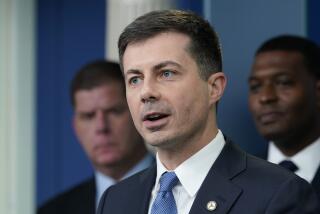Why tarmac delay rules are bad for airline passengers
The Timesâ Dec. 22 editorial on the federal governmentâs rule requiring airliners that sit on the tarmac for more than three hours to disembark passengers was surprisingly astute -- surprising because the sensible observations and conclusions that The Times expressed have been so rarely understood or articulated in this emotion-charged debate. Ever since a very few but very public events -- in December 2006, February 2007 and then one flight this past summer in Rochester, Minn. -- many have made âfixingâ this problem a cause celebre.
A few months ago, I was invited to testify on this subject at an unofficial congressional hearing. Unfortunately, it was not much of a fact-finding event. Sens. Barbara Boxer (D-Calif.) and Amy Klobuchar (D-Minn.) pledged their commitment to outlawing long taxi times but departed the scene before University of Michigan engineering professor Amy Cohn (a researcher who has specialized in methods to improve the efficiency and reliability of flight operations) and myself (a retired airline executive who, for many years, oversaw the flight operations control functions at a large airline, but who is no longer employed in or by the airline industry) made many of the points that The Times made in its editorial:
* Flights with very long taxi times are extremely rare events.
* They are almost always the result of well-intentioned pilots and dispatchers desperately trying to get their customers to their destinations, safely.
* Forcing airplanes to return to the gate after three hours will invariably cause many of these returning flights to be canceled, stranding airline customers for hours or days.
* The biggest contributing factors to this problem are insufficient aviation system capacity, an aging air traffic control system that we somehow cannot manage to fund and upgrade, and air traffic control procedures that make it terribly disadvantageous to leave the takeoff queue and return to the gate.
How disappointing that our governmentâs solution is to simply issue a decree making long taxi times illegal. This, and Department of Transportation Secretary Ray LaHoodâs comments on the subject, reaffirm how little the government understands about the airline business. It opted for political expediency and sound-bites instead of a real fix, despite the fact that the Transportation Departmentâs multi-disciplinary Tarmac Delay Task Force recommended against this âthree hour ruleâ as a solution to the problem. And LaHoodâs dismissive comments about the expressed concerns are insulting to those of us who have tried to point out the painful, unintended consequences of this rule change. The truth is that we are trying to explain some of the realities of air travel and avoid bad regulation that is going to harm many consumers.
Scott Nason is a recently retired vice president from American Airlines, where he spent 29 years in flight operations, information technology and revenue management.
More to Read
A cure for the common opinion
Get thought-provoking perspectives with our weekly newsletter.
You may occasionally receive promotional content from the Los Angeles Times.










